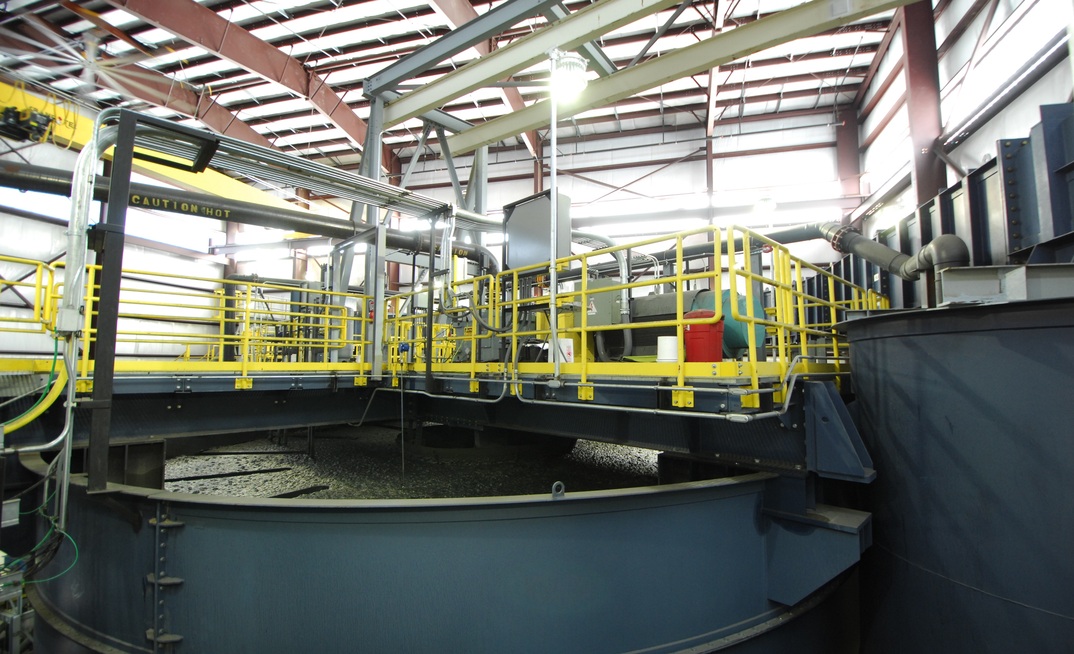Ore grades in mines are getting lower, as many of the easily accessible high-grade deposits have already been mined. In general, as ore grades dip, a much larger amount of rock and ore must be processed to achieve the same quantity of final product. Many mine sites are getting bigger and are pushing their throughput to maintain the same mineral production and profitability that they previously did.
As a result, mines are asking more from their unit operations and equipment - in existing operations, this means that the flotation process must handle more tonnes within the same amount of time, often leading to crowding of equipment and running beyond design capacity.
Charles Andress, technical leader at Nalco, says: “One often seen consequence of this is that sites will increase throughput through their milling circuit, resulting in a coarser grind being sent downstream to the flotation circuit.”
Lower grade ores have not been affected so far by a change in the liberation size or in the retention time compared to ‘standard’ grade ores. Thierry Monredon, director, process equipment – flotation and hydrocyclones at Metso, explains: “As a result, the main impact comes from the increased capacities required to decrease operating costs. Larger volumes for the flotation cells, in the range of 600m3, have been developed by all major flotation suppliers to address this requirement.”
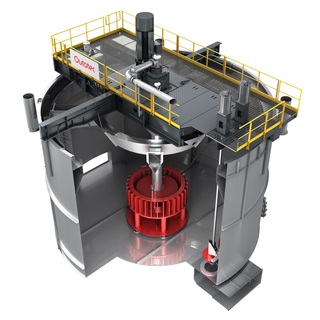
To keep the cost of new plants down, the general trend is to go for larger flotation cells. Ben Murphy, technology director – flotation at Outotec, says: “In the past few years, we have seen a massive increase in our installed base of 300m3 cells. We have had a 500m3 cell operational since 2014 and we expect a number of 630m3 cells to come online later this year.”
The primary driver for the large flotation cells are the copper miners wanting to benefit from the economies of scale. The declining grade trend varies by commodity and this is most evident in the production of copper, gold, nickel and zinc.
“In fields like phosphate, potash and coal we are still seeing grades maintained, but certainly the ore is becoming more complex and new mineral processing plants are also starting to have more complex flowsheets,” notes Andress. “For industries like coal and gold, we are seeing flotation added to improve recoveries but it is only responsible for part of production so doesn’t get the same level of attention as a mill where all their production is through flotation."
More water is also required for the same amount of produced product. Frank Cappuccitti, president at Flottec, says: “Since collector is added for flotation of the valuable minerals, the amount of collector used will not change much with the higher tonnage feed. However, the frother works in the water phase so the amount of frother used will increase based on the water increase.”
In terms of the chemicals used for flotation, the lower grades do not directly change the basic reagent optimisation approach; however, lower grades involve complex mineralogy, which requires more selective collectors to treat the ore than the standard chemicals currently being used.
Bill Hancock, technical marketing specialist at FMC Cheminova, explains: “These lower grade ores are often and generally fraught with much mineralogy, surface chemistry and consequent bulk water chemistry impacts as well as liberation issues. Furthermore, gangue entrainment influences reagent scheme frothing properties and circuit design to ensure saleable grade concentrates are produced.”
He adds: “Because the flotation issues typically are more complex with these previously undesired low-grade ores, identifying an optimum combination of reagent suite, system design and operating strategies is more difficult. Identifying the optimum combination of flotation reagents and process conditions is challenging due to the wide ore variability typically associated with these deposits makes defining overall optimum operating conditions for the range of ore conditions that is experienced within an operating shift or day difficult.
“From a flotation reagent supplier perspective, flotation collector blends and matching frothers can be tools for improving hydrophobicity and hydrodynamics to maximise recoveries at target concentrate grades. Due to ore variability, identifying and proving reagent suite optimality requires more effort.”
In developing new deposits that have low grade, the flotation process must be designed to compete economically with existing deposits. This puts a heavy burden on engineering, equipment design and reagent companies to work together to develop a system that will provide a viable solution.
Todd Parker, global marketing manager – mining at ArrMaz, says: “Low-grade deposits will only come online if the cost of the concentrate produced can compete with market prices. It is wise for those developing new deposits to work with reagent companies to understand the potential of a new reagent system to improve grade and recovery while keeping costs competitive.”
Benefits of coarse flotation
There are several potential advantages of using coarse flotation in mineral processing which is not currently being taken advantage of in many mines. Benigno Ramos, mining chemicals metallurgical manager at Chevron Phillips Chemical Co, tells Mining Magazine: “Typically, in flotation the recovery curve will show an inverted ‘U’ shape for recovery, with the two lowest points being on either side - namely the finer and coarser particles - with the highest recovery in the middle-sized particles. Coarse particle flotation would enhance recovery, possibly with pre-concentration or with a need for regrinding in the cleaner circuit to maintain grade.”
Murphy agrees: “If you plotted flotation recovery against particle size, recovery is relatively high for particles in the 50-150μm range. Outside this range, the recovery falls off rapidly. At the coarse end, it quickly reaches a point in most systems where the particles are not recovered. In producing plants, it is around the 200μm mark. Getting particles at this coarse end of the spectrum to float is a balancing act getting the right particle properties, chemical conditions and the hydrodynamic conditions created by the flotation equipment.
“If we could extend this, improving efficiencies for particles even in the 200-400μm range, this would likely have a significant impact on how plants are designed and operated.
“The ‘holy-grail’ of coarse flotation would be a situation where you could do a coarse grind and float off most of the valuable material, then regrind and retreat this smaller stream; this would potentially have big capital and operating cost savings, especially in energy used to grind the ore. What controls this is the liberation characteristics of the ore being treated. Obviously the coarser the float the more savings would be possible.”
A huge benefit of floating coarser materials is cost savings. One of the most significant ways coarse flotation saves money is by reducing or eliminating the need to grind or reduce particle size to enable flotation. If the mineral is naturally liberated, then the flotation process bears the burden of having to float the mineral at its natural size. A coarser grind produces an ore with lower surface area, and especially if fines can be minimised then reagent consumption can be likewise reduced.
Parker says: “Sizing plays a critical role in the ability to float coarse particles. The process of grouping size fractions into similar sized bandwidths, and then designing the flowsheet, equipment and reagents to maximise grade and recovery, has enabled the economical utilisation of many deposits around the globe. Being able to size and float at the coarsest fraction possible enables low-cost mineral processing while meeting grade and recovery requirements.”
Floating at coarser particle sizes also has great economic benefit directly related to higher grinding mill throughput and reduced grinding steel and electrical costs. The milling circuit is often the bottleneck in the plant, so increasing throughput increases plant and metal production and profits.
Hancock notes: “There is always a demand to reduce costs while maintaining recoveries. Unfortunately, particle liberation is a limitation in conventional mechanical flotation cells due to the mechanism and hydrodynamics, so as a generality, better liberation provides better metallurgical results.”
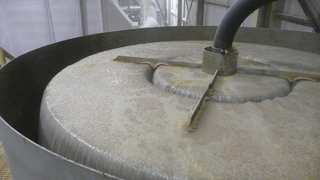
Technologies such as the Eriez Flotation Division’s HydroFloat Separator for coarse particle mineral concentration address this – it is designed to effectively float poorly liberated ores at very coarse sizes. By utilising this separator, the amount of grinding energy and equipment can be dramatically reduced; the technology can recover particles with as little as 5% surface exposure.
Wagner Silva, global iron ore technology manager – BL Mining – Clariant BU OMS, says: “In addition, coarse flotation generates energy consumption savings, which in itself saves costs.” Grinding is generally the most expensive and energy intensive part of the mineral processing operation, so increasing the grind size can significantly reduce electricity usage and costs.
Eric Wasmund, global managing director for the Eriez Flotation Division, says: “The observation known as Hukki’s conjecture describes that more energy is required to grind particles that are smaller in size. Therefore, grinding ore down to 400μm for coarse particle flotation will use much less energy and equipment than grinding down to 150μm for conventional flotation, as an example.
“Another benefit is that a significant percentage of the run-of-mine ore can be separated and rejected while it is still very coarse, often between 400-600μm. This enables easier handling, dewatering and impounding.”
Coarse flotation also impacts the dewatering circuit, as a coarser particle size distribution increases the settling rate and dewatering characteristics of the slurry. This allows the installed dewatering technologies, with minimal if any modifications, to process the increase in concentrator tonnes.
However, Andress cautions: “Coarser grinding does have its downsides. Floating coarser particles will mean lower liberation of the mineral which decreases concentrate grades. The coarser particles also can shift load onto re-grind circuits and other parts of the flotation circuit.”
Tank design
Flotation tank designs have been adapted in several ways to accommodate lower grade or more complex ores, as well as higher throughputs.
Improvements in coarse particle recovery can be achieved by proper flotation equipment selection and equipment design modifications. The cell volume of the flotation units can be scaled up using existing technologies to be as large as possible to handle larger flows. This approach has led to the introduction of larger and larger flotation units.
However, Murphy cautions: “One of the challenges facing the industry is that flotation cell sizing and scale-up methodology has not really changes since the 1970s. Engineers are applying the same rules to large cylindrical tank cells that they applied to 8-16m3 square cells in the 1970s. This is despite the newer tanks being a different geometry and far more efficient in mixing and air dispersion. There is opportunity to improve here.”
For example, FLSmidth has completed research into tank to diameter ratios that concluded that large volume forced air cells can have aspect ratios (the ratio of the width to the height) of 1:1. Asa Weber, product manager of flotation and dewatering at FLSmidth, advises: “With this height to diameter ratio, the flotation machine can be operated at froth depths equal to a column's operation. This allows improvements in concentrate grades with the benefit of higher recovery. There is the added benefit of higher aspect ratio tanks as both equipment cost and plant footprint are both decreased.”
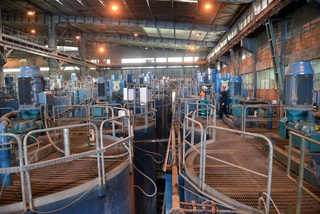
Along with large volume flotation cells, efficient mechanism design and some circuit flexibility are important. Monredon says: “Such flexibility can be obtained by combining the use of mechanical cells in the rougher/scavenger circuits and column cells in the last cleaning stages. Metso, as one of the main flotation equipment suppliers, has integrated all these aspects in its flotation equipment range.”
Another approach is to look at the fundamental flotation science to see if there is a more efficient way to do it. For instance, theoretical flotation models suggest that there is a strong relationship between bubble-particle collision rates and particle size distribution.
George Robles, key account manager at FLSmidth explains: “For fine particles, flotation kinetics is improved by higher energy dissipation rates that increase collision frequencies between bubbles and particles. Conversely, flotation kinetics of coarser particles is often diminished at higher energy dissipation rates due to higher detachment rates associated with turbulence in the rotor-stator region. Other restrictions to coarse particle recovery are bubble-particle aggregate buoyancy and froth recovery.”
A factor that is not always considered when engineering a plant with these large cells is froth management. “This is especially critical, as the grades get lower,” says Murphy. “As tanks got scaled up many of them kept the same geometry and configuration as they had in a smaller tanks. As the tank size got larger, the diameter increased and so did the froth surface area.”
To maintain a stable froth on a flotation cell two things are needed: sufficient particles and sufficient frother (a chemical that stabilises the bubbles). Murphy states: “As grades get lower the particle concentration in the froth will become less - this is especially bad at the tailings end of a flotation circuit. As you only have a finite volume of froth to play with if your surface area on the cell gets larger, the froth depth you can run at gets shallower.
“A shallow froth depth does not allow for good selectivity, and in addition it can cause control headaches for operators. Tailoring the flotation cell surface area for a particular ore and a position in the bank is key to optimising flotation performance."
This can be done by adding adjustable froth crowders or radial froth crowders to reduce surface area and optimise froth recovery. In some cases, additional launders may be used to promote froth recovery as well. Internal or external froth launders need to be considered for cell design criteria - if at all possible, internal launders are preferred to external launders as internal launders minimise both froth travel distance and row length.
Weber says: “The former benefits metallurgical recovery and the latter decreases installation cost. However, volume is proportional to diameter cubed and froth area is proportional to diameter squared. This physical phenomenon can result in adequate residence time but inadequate froth surface area. With lower grade, higher throughput or complex ore applications, external launders may need to be incorporated to address any carry capacity limitations.”
Murphy declares: “The bottom line is that it does not matter how good your mechanism and in pulp kinetics are - if the froth doesn’t go over the lip, the recovery is zero!”
Flotation reagents
Complex ores, from which several valuable minerals can be recovered while rejecting multiple gangues, create the most challenging scenario for today’s metallurgists. The ability to process and float comingled minerals from the same orebody is becoming more prevalent and economical.
Andress comments: “There is a perception at times in the industry that flotation problems can be solved by innovations on the equipment side and there are certainly some powerful innovations coming through that side of the business. However, to truly realise flotation gains these need to be solve with partnerships on the reagent side.”
As lower grade ores typically pose more challenging mineralogy and surface chemistry variability and difficulty challenges, the differences in these conditions often require a different optimum reagent suite.
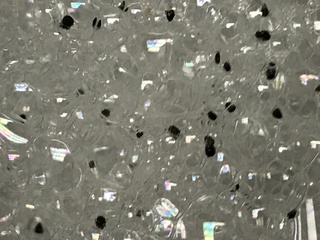
Parker says: “Understanding the flotation process, from the exploration phase through to production optimisation, is key to developing reagents that can successfully discover your ore’s true potential by unlocking maximum value throughout the entire beneficiation process. In many cases, deposits that were economically unfeasible years ago are now coming onto production as a result of advances in reagent formulation, sizing and flotation equipment design, as well as flowsheet design which all must work together to effectively process the most troublesome of ores.”
As a result, the application of flotation reagents has changed in recent years. “Over the last decade, we have begun to understand the flotation process more extensively,” explains Cappuccitti. “Much research has been conducted on the importance of the hydrodynamics of flotation cells and how the hydrodynamics is affected by reagents. We have learned how to measure the hydrodynamic parameters in flotation cells. We have learned that flotation circuits work best at the minimum bubble size for both coarse and fine particles and therefore, circuits should be run at the CCC [critical coalescence concentration] of the frother at all times for optimum performance. But, as the new flotation machines for coarse particles are developed, we must challenge this idea and determine if larger bubbles are required as we stretch the upper limit of coarse particle flotation.”
To float coarser materials, stronger and stronger frothers are needed to keep the particles suspended. Additionally, some sites can quickly shift between harder and softer seams of ore, which means that the particle size distribution can swing wildly and quickly. Andress says: “As such Nalco have focused on developing frothers with the strength to keep larger particles suspended but to maintain the right level of mobility and persistence so that the circuit keeps running efficiently. As mines are moving to more complex flotation circuits it’s critical that they get a frother that’s designed for their circuit rather than a generic reagent.”
Cappuccitti notes: “We have also learned that each frother has a distinct relationship between its ability to create froth, water content in the froth and bubble size generation that is dependent on the air rate of the cell. This can be described as a hydrodynamic curve of a frother. Each system requires a specific hydrodynamic curve for optimum performance. If the ore feed is highly variable, each ore may require different hydrodynamic characteristics so therefore, dual frother systems (the addition of a weak and strong frother at different ratios depending on the needs of the system) are now being employed in the reagent scheme.”
On the collector side there is also a need to drive towards more selective and speciality reagents. Andress says: “Unselective bulk collectors like xanthates are very effective in floating large volumes, but as we began processing more complicated ores there has been a big shift towards more selective collectors to maintain concentrate grades.”
To accommodate high ore response variability, blends of collectors are required to ensure that values are appropriately hydrophobic under the circuit operating conditions to be recovered. As a result, optimum flotation suites entail multiple collector components that are able to improve, or at least maintain, the flotation performance in the presence of more complex ores.
Current trends
Various new technologies are being field tested to address the need to float coarser particles and reduce the size of the energy-intensive grinding circuit, including rotorless pneumatic type flotation processes. Robles explains: “In theory, the purpose is to have a smaller grinding circuit by grinding coarser, floating the coarse particles at equivalent mineral recovery, followed by regrinding to the required liberation size to produce a valuable concentrate.”
He tells MM that topics of FLSmidth’s interest and research include:
- Alternative flotation technologies that reduce residence time and foot print through reduced fluid dispersion or the separation of collision and attachment sub-processes;
- Deployment of ore pre-concentration technology to separate waste rock prior to processing;
- Separation techniques which minimise or eliminate water consumption;
- Grinding technologies that may increase throughput at minimised power consumption yet allowing for acceptable maximum mineral recovery;
- Predictive wear and maintenance technologies;
- New froth removal techniques; and
- Digitalisation of flotation circuits to maximise utilisation and minimise OPEX.
Murphy thinks that the next big focus for many operators will be looking to get the correct froth management in their flotation cells. He says: “The focus on efficiency has been largely on the mechanism and in-pulp kinetics, and I think now with the larger cells operators are realising that there are significant gains to be made in better managing the froth on their cells.”
If mining companies want to start looking at coarse particle flotation, focusing on the launder and crowding configuration is even more critical because coarser particles are more likely to fall out of the froth. As a result, minimising froth retention time and transport distance required for these particles to reach a launder is key.
Monredon suggests: “For ‘standard’ particle sizes – let’s say between 15-200µm - flotation equipment has become a commodity item and all Western suppliers have already optimised their mechanism design. In order to maximise metallurgical performance, it is now required to expand the use of froth cameras like the Metso VisioFroth with advanced process control since this type of system can typically generate a 1% increase in plant recovery.”
He also adds that for coarse flotation, more research is needed to be applied in pre-concentration, especially for sulphide applications. He comments: “Flotation suppliers are adapting their equipment or developing new equipment to handle coarse particles (suspension and wear) and maximise their recovery. In mechanical cells, the use of over-sized mechanisms has already proven its benefit.”
From an equipment perspective, Wasmund thinks that the biggest trend is the gradual acceptance of the idea that flowsheets can be optimised by using a split-feed approach. This means splitting the feed by size and floating the coarse stream using a different unit than the fine stream.
“Flotation equipment is ready to become specialised,” he says: “This will mean that other flotation technologies will become specialised as well. Eriez Flotation Division is already seeing collectors that are specially formulated for coarse particles, for instance. This approach will allow the use of specially adapted technology - such as the HydroFloat - to be used in concentrators in the near future.”
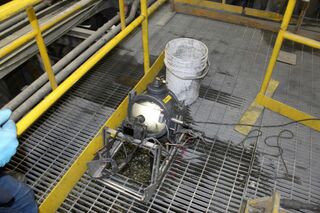
Cappuccitti suggests that the latest trend in flotation will be the use of new sensors to measure specific hydrodynamic parameters to control the flotation circuit. “The most promising new control parameter is gas hold-up,” he declares. “As the solids, mineral, air rate and reagents are changed, the gas hold-up in a cell changes. As gas hold-up changes, so does the retention time in a circuit. As gas hold-up increases, flotation becomes more efficient but residence time drops. So, there is an expected optimum gas hold-up where efficiency and retention time are optimum. New sensors are available that can provide this measurement that can help operators keep the circuit performing at its best level.”
In the future, true circuit optimisation will come from a complete understanding of the mineralogy of the ore, the flotation kinetics associated with the various levels of liberation and grind size, the chemistry and hydrodynamics of the circuit, and a process control (expert) system that maintains the circuit at optimum. “A holistic approach is necessary for optimisation,” says Cappuccitti. “The magic bullet approach where one change will fix everything will not work, unless there is some unlikely fundamental mistake in the operation of a mill.”
In the flotation reagent area, dramatically increased hydrodynamic understanding has enhanced an engineering approach to reagent optimisation. Debbie Laney, mining chemicals metallurgical manager at Chevron Phillips Chemical Co, states: “Specialty or higher specificity reagents are becoming more in demand.”

Reagent suite optimisation is now more clearly understood as requiring the consideration of both collector and frother chemistry combinations. Hancock says: “In response, FMC Cheminova has added frothers to our line to improve the response of our collectors. This is because our products often provide unique responses that must be captured and accommodated with frother changes which have led to improved metallurgical performance versus alternative products and combinations.”
Lower grade ores have different and complex mineralogy, and can require more advanced flotation collectors than the ones currently available. Silva explains: “The research and development of customised collectors for new ores is required in order to optimise ore recovery, reduce the losses of valuable minerals to the tailings, and to allow the ore flotation process to become more sustainable.”
The creation of finer bubbles in the flotation circuit is also seen as a growing trend. Andress says: “This will be driven by innovation in the equipment side of the industry, but the reagent suppliers will have a major part to play here too.”
He concludes: “The flotation industry is still somewhat fragmented. Each of the equipment suppliers, customers and reagent suppliers are working on their own development programmes. Increasing partnerships between customer, equipment and chemical suppliers will be needed help solve the mining industries problems.”


